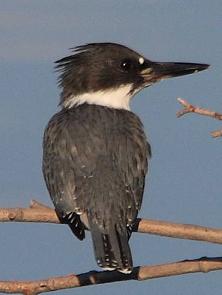Belted Kingfisher 
Identification and Pictures
(Megaceryle alcyon)
Belted Kingfishers are easy to identify with
their large head, bushy crest, and large black bill. They
are stocky, noisy fishing birds, 11 to 14 1/2 inches.
Their plumage is blue gray above with a large white collar, a
broad gray breast band, and white under parts. They have a small white spot by each eye.
Females have rusty a band that goes across the breast, and down
the sides, making Kingfishers one of the few birds where the
female is more colorful than the male. Juvenile males will have a
mottled rusty band, and young females have a rusty band that is
not as pronounced as it is in the adults.
They are often seen hovering in the air with
rapid beating wings, as they prepare to dive into the water
for a fish. They can be recognized in flight by their
deep uneven wing beats.

Photo by Keith
Lee. The camera I use is the Canon
EOS 40D. Visit All-birds store
In
1986 Canada ran the Birds of Canada series on their currency. The
Kingfisher was on the 5 dollar bill.

Sound
The voice of the Kingfisher is a loud high
rattle. They often give this as they take off or prepare
to dive into water. Sound
Preferred Habitat
Belted Kingfishers range extends across North
America. Northern populations migrate south. In
warmer climates the birds are resident all year. They
can be found around bodies of water such as rivers, streams,
ponds, lakes, or coast line.
Breeding and Nesting
After the male establishes a territory he
sings mewing songs to attract a mate. During courtship
he will catch fish to feed her. Pairs once formed are
monogamous. A typical nest is a burrow in a river bank excavated by both
sexes. In addition to their large bill, they are aided
in their digging by two of their toes that are fused together
providing them with a built in shovel. During excavation
the two birds will constantly rattle to each other. The
burrow will slope up hill, leaving an air pocket for the young
incase of flooding. Females usually lay 5 to 8 white
eggs which are incubated by both birds for about 3
weeks. Both adults will take care of the young
birds which will fledge in about 4 weeks. The young
birds will stay with, and be fed by the parents for about 3
more weeks.
Food
The main diet of Kingfishers is fish however
they also eat other aquatic life such as frogs, crayfish, snails,
tadpoles, and insects. They like to perch above clear
water so they can dive when they see their prey. Often
they will hover in the air with rapidly beating wings,
plunging into the water when they see a fish.
To learn about other favorite
birds click here.

|
